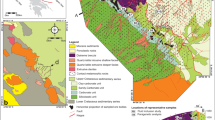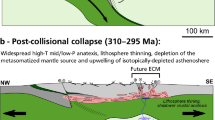Abstract
Amphiboles from the Galinge skarn deposit, the largest iron (Fe) polymetallic skarn deposit in the Qiman Tagh metallogenic belt (western China), were formed by multistage fluid-rock interactions. Mineral analysis of the various amphiboles suggest that they were formed by the replacement of mafic to intermediate igneous rocks. The two alteration phases have formed three generations of compositionally distinct amphiboles: Amp-I: Ferro-edenitic hornblende (FE); Amp-II: Deep bluish-green magnesian-hastingsite (MH); Amp-III: Light greenish-beige ferro-actinolite (FA). The Amp-I preserves the primary igneous amphibole composition, and was subsequently replaced by Amp-II. The amphibole Cl content markedly increases from the FE (0.176 − 0.582 wt.%) to the MH (0.894 − 3.161 wt.%), and abruptly drops in the FA (0.017 − 0.039 wt.%). The Cl-rich MH contains the lowest concentration of Si [5.64 − 6.28 atoms per formula unit (apfu)], and the highest (K + Na) values (0.72 − 1.06 apfu) in the amphibole A-site with a high K/(K + Na) of 0.491 to 0.429. Both Mg and Fe contents of the MH and FA vary widely, possibly due to the interactions of magma-derived hydrothermal fluids with the basaltic / andesitic host rocks.
Formation of the Cl-rich MH may have been associated with the early high-temperature and high-saline hydrothermal fluids, meanwhile the Cl-poor FA may have formed from later low-temperature and low-saline hydrothermal fluids. The MH plays an important role for consuming Cl carried by hydrothermal fluids. The Cl-rich fluids may have mobilized some elements, such as Fe, Al, Mg, Ca and Ti from the host rocks. Considerable amounts of Ti, Al, Mg and Fe were incorporated into the sphene and Fe-Ti oxides that coexist with the MH.















Similar content being viewed by others
References
Baker J, Spiegelman M (1995) Modelling an infiltration-driven geochemical front. Earth Planet Sc Lett 136:87–96
Bally AW (1986) Notes on sedimentary basins in China: report of the American sedimentary basins delegation to the People's Republic of China. Department of the Interior, US Geological Survey, 86-327
Bodnar RJ, Vityk MO (1994) Interpretation of microthermometric data for H2O-NaCl fluid inclusions. Fluid Inclusions in Minerals: Methods and Applications:117–130
Dick LA, Robinson GW (1979) Chlorine-bearing potassian hastingsite from a sphalerite skarn in southern Yukon. Can Mineral 17:25–26
Duke EF (1995) Contrasting scales of element mobility in metamorphic rocks near Harney Peak Granite, Black Hills, South Dakota. Geol Soc Am Bull 107:274–285
Dutrow BL, Foster CT, Henry DJ (1999) Tourmaline-rich pseudomorphs in sillimanite zone metapetites: Demarcation of an infiltration front. Am Mineral 84:794–805
Einaudi MT, Burt DM (1982) Introduction; terminology, classification, and composition of skarn deposits. Econ Geol 77:745–754
Enami M, Liou JG, Bird DK (1992) Cl-bearing amphibole in the Salton Sea geothermal system, California. Can Mineral 30:1077–1092
Feng CY, Li DS, Wu ZS, Li JH, Zhang ZY, Zhang AK, Shu XF, Su SS (2010) Major types, time-space distribution and metallogenesis of polymetallic deposits in the Qimantage metallogenic belt, eastern Kunlun area. Northwest Geol 43:10–17
Feng CY, Zhao YM, Li DX, Liu JN, Xiao Y, Li GC, Ma SC (2011) Skarn types and mineralogical characteristics of the Fe-Cu-polymetallic skarn deposits in the Qimantage area, Western Qinghai Province. Acta Geol Sin 85:1108–1115
Feng CY, Wang S, Li GC, Ma SC, Li DS (2012) Middle to Late Triassic granitoids in the Qimantage area, Qinghai Province, China: Chronology, geochemistry and metallogenic significances. Acta Petrol Sin 28:665–678
Frost BR, Lindsley DH (1992) Equilibria among Fe-Ti oxides, pyroxenes, olivine, and quartz: Part II. Application Am Mineral 77:1004
Grigsby JD (1990) Detrital magnetite as a provenance indicator. J Sediment Res 60:940–951
Hawthorne FC, Oberti R (2006) On the classification of amphiboles. Can Mineral 44:1–21
Hawthorne FC, Oberti R, Harlow GE, Maresch WV, Martin RF, Schumacher JC, Welch MD (2012) Nomenclature of the amphibole supergroup. Am Mineral 97:2031–2048
Hemley JJ, Cygan GL, Fein JB, Robinson GR, D'Angelo WM (1992) Hydrothermal ore-forming processes in the light of studies in rock-buffered systems; I, Iron-copper-zinc-lead sulfide solubility relations. Econ Geol 87:1–22
Hu H, Lentz D, Li J, Mccarron T, Zhao X, Hall D (2015) Reequilibration processes in magnetite from iron skarn deposits. Econ Geol 110:1–8
Jacobson SS (1975) Dashkesanite: high-chlorine amphibole from St. Paul's rocks, Equatorial Atlantic and Transcaucasia, USSR. Smithson. Contrib. Earth Sci 14:17–20
Krutov GA (1936) Dashkesanite, a new chlorine amphibole of the hastingsite group. Mineral Abstr 6:438
Leake BE (1978) Nomenclature of amphiboles. Can Mineral 16:501–520
Leake BE, Woolley AR, Arps C, Birch WD, Gilbert MC, Grice JD, Hawthorne E, Kato A, Kisch HJ, Krivovichev VG (1997) Nomenclature of amphiboles report of the subcommittee on amphiboles of the International Mineralogical Association Commission on new minerals and mineral Names. Eur J Mineral 61:295–361
Leake BE, Woolley AR, Birch WD, Burke EA, Ferraris G, Grice JD, Hawthorne FC, Kisch HJ, Krivovichev VG, Schumacher JC (2004) Nomenclature of amphiboles: Additions and revisions to the International Mineralogical Association’s amphibole nomenclature. Am Mineral 89:883–887
Lepage LD (2003) ILMAT: an Excel worksheet for ilmenite–magnetite geothermometry and geobarometry. Comput Geosci 29:673–678
Li GM, Shen YC, Liu TB (2001) Geological and geochemical characteristics of Variscan granite in the Qimantage Region, Eastern Kunlun. Geophys Prospect 1:16
Luo ZH, Deng JF, Cao YQ, Guo ZF, Mo XX (1999) On late Paleozoic-early Mesozoic volcanism and regional tectonic evolution of Eastern Kunlun, Qinghai Province. Geoscience 13:51–56
Luo ZH, Ke S, Cao YQ, Deng JF, Zhan HW (2002) Late Indosinian mantle-derived magmatism in the East Kunlun. Geol Bulletin China 21:292–297
Makino K, Tomita K, Suwa K (1993) Effect of chlorine on the crystal structure of a chlorine-rich hastingsite. Mineral Mag 57:677–686
Mao JW, Zhou ZH, Feng CY, Wang Y, Zhang C, Peng H, Miao Y (2012) A preliminary study of the Triassic large-scale mineralization in China and its geodynamic setting. Geol China 39:1437–1471
Meinert LD (1984) Mineralogy and petrology of iron skarns in western British Columbia, Canada. Econ Geol 79:869–882
Meinert LD (1992) Skarns and skarn deposits. Geosci Can 19:145–162
Meinert LD (1993) Igneous petrogenesis and skarn deposits. Mineral deposit modeling 40:569–583
Meinert LD, Hedenquist JW, Satoh H, Matsuhisa Y (2003) Formation of anhydrous and hydrous skarn in Cu-Au ore deposits by magmatic fluids. Econ Geol 98:147–156
Morrison J (1991) Compositional constraints on the incorporation of Cl into amphiboles. Am Mineral 76:1920–1930
Munoz JL, Swenson A (1981) Chloride-hydroxyl exchange in biotite and estimation of relative HCl/HF activities in hydrothermal fluids. Econ Geol 76:2212–2221
Nadoll P, Angerer T, Mauk JL, French D, Walshe J (2014) The chemistry of hydrothermal magnetite: a review. Ore Geol Rev 61:1–32
Nielsen RL, Forsythe LM, Gallahan WE, Fisk MR (1994) Major-and trace-element magnetite-melt equilibria. Chem Geol 117:167–191
Oberti R, Ungaretti L, Cannillo E, Hawthorne FC (1993) The mechanism of Cl incorporation in amphibole. Am Mineral 78:746–752
Öztürk YY, Helvacı C, Satır M (2008) The influence of meteoric water on skarn formation and late-stage hydrothermal alteration at the Evciler skarn occurrences, Kazdağ, NW Turkey. Ore Geol Rev 34:271–284
Roedder E, Bodnar RJ (1980) Geologic pressure determinations from fluid inclusion studies. Annu Rev Earth Pl Sc 8:263
Sato H, Yamaguchi Y, Makino K (1997) Cl incorporation into successively zoned amphiboles from the Ramnes cauldron, Norway. Am Mineral 82:316–324
Suwa K, Enami M, Horiuchi T (1987) Chlorine-rich potassium hastingsite from West Ongul island, Liitzow-Holm bay, East Antarctica. Mineral Mag 51:709–714
Toplis MJ, Carroll MR (1995) An experimental study of the influence of oxygen fugacity on Fe-Ti oxide stability, phase relations, and mineral-melt equilibria in ferro-basaltic systems. J Petrol 36:1137–1170
Van Baalen MR (1993) Titanium mobility in metamorphic systems: a review. Chem Geol 110:233–249
Vanko DA (1986) High-chlorine amphiboles from oceanic rocks: product of highly saline hydrothermal fluids. Am Mineral 71:51–59
Verlaguet A, Brunet F, Goffé B, Murphy WM (2006) Experimental study and modeling of fluid reaction paths in the quartz - kyanite ± muscovite - water system at 0.7 GPa in the 350–550°C range: implications for Al selective transfer during metamorphism. Geochim Cosmochim Ac 70:1772–1788
Wang BZ, Luo ZH, Li HY, Shen HW, Hu XL (2009) Petrotectonic assemblages and temporal-spatial framework of the Late Paleozoic-Early Mesozoic intrusions in the Qimantage Corridor of the East Kunlun belt. Geol China 36:769–782
Webster JD (1997) Exsolution of magmatic volatile phases from Cl-enriched mineralizing granitic magmas and implications for ore metal transport. Geochim Cosmochim Ac 61:1017–1029
Webster JD, Rebbert CR (1998) Experimental investigation of H2O and Cl− solubilities in F-enriched silicate liquids; implications for volatile saturation of topaz rhyolite magmas. Contrib Mineral Petrol 132:198–207
Webster JD, Kinzler RJ, Mathez EA (1999) Chloride and water solubility in basalt and andesite melts and implications for magmatic degassing. Geochim Cosmochim Ac 63:729–738
Wilkinson JJ (2001) Fluid inclusions in hydrothermal ore deposits. Lithos 55:229–272
Wu YZ, Qiao GB, Chen DH (2011) A preliminary study on relationship between tectonic magmatism and mineralization in Qimantage area, Eastern Kunlun Mountains. Geotecton Metallog 35:232–241
Xu ZQ, Yang JS, Li WC, Li HQ, Cai ZH, Yan Z, Ma CQ (2013) Paleo-Tethys system and accretionary orogen in the Tibet Plateau. Acta Petrol Sin 29:1847–1860
Yu M (2013) Geochemistry and zonation of the Galinge iron deposit, Qinghai province. China University of Geoscience, Bejing, p 1–106
Yu M, Feng CY, Bao GY, Liu HC, Zhao YM, Li DX, Xiao Y, Liu JN (2013a) Characteristics and zonation of skarn minerals in Galinge iron deposit, Qinghai Province. Mineral Deposits 32:55–76
Yu M, Feng CY, Xiao Y, Liu JN, Li DX, Li GC, Ma SC (2013b) Features and evolution of metallogenic fluid in Jiadanggen porphyry copper deposit of Gonghe Country, Qinghai Province. Mineral Deposits 32:133–147
Yu M, Feng CY, Zhao YM, Li DX, Xiao Y, Liu JN, Li ZF (2014) Fluid inclusion geochemistry in the Kaerqueka copper polymetallic deposit, Qinghai Province and its genetic significances. Acta Geol Sini 88:903–917
Yu M, Feng CY, Liu HC, Li DW, Zhao Y, Li DX, Liu JN, Wang H, Zhang MH (2015a) 40Ar-39Ar geochronology of the Galinge large skarn iron deposit in Qinghai province and geological significance. Acta Geol Sini 89:510–521
Yu M, Feng CY, Zhao YM, Li DX (2015b) Genesis of post-collisional calc-alkaline and alkaline granitoids in Qiman Tagh, East Kunlun, China. Lithos 239:45–59
Zhang JX, Meng FC, Wan YS, Yang JS, Dong GA (2003) Early Paleozoic tectono-thermal event of the Jinshuikou Group on the southern margin of Qaidam: Zircon U-Pb SHRIMP age evidence. Geol Bulletin China 22:397–404
Zhao YM, Feng CY, Li DX, Liu JN, Xiao Y, Yu M, Ma SC (2013) Metallogenic setting and mineralization-alteration characteristics of major skarn Fe-polymetallic deposits in Qimantag area, western Qinghai Province. Mineral Deposits 32:1–19
Acknowledgments
This study was jointly financially supported by the National Natural Science Foundation of China (Grant 41172076), the Program of High-level Geological Talents (201309) and Youth Geological Talents (201112) of the China Geological Survey, Geological Survey Program (Grant 1212011085528) from the China Geological Survey, and the Scientific Research Fund (Grant 201411025) of the Non-Commercial Unit from Ministry of Land and Resources, China.
Thanks are due to the Editor-in-Chief Johann G. Raith and Associate Editor Georg Hoinkes for editorial handling, and to the two reviewers for their constructive and thoughtful comments. Cenozoic Geoscience Editing is acknowledged for their language polishing and scientific editing services.
Author information
Authors and Affiliations
Corresponding author
Additional information
Editorial handling: G. Hoinkes
Rights and permissions
About this article
Cite this article
Yu, M., Feng, C.Y., Zhu, Y.F. et al. Multistage amphiboles from the Galinge iron skarn deposit in Qiman Tagh, western China: evidence of igneous rocks replacement. Miner Petrol 111, 81–97 (2017). https://doi.org/10.1007/s00710-016-0459-x
Received:
Accepted:
Published:
Issue Date:
DOI: https://doi.org/10.1007/s00710-016-0459-x




